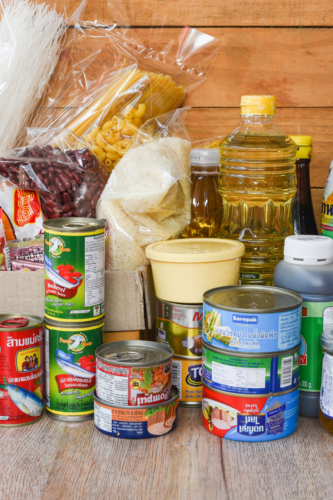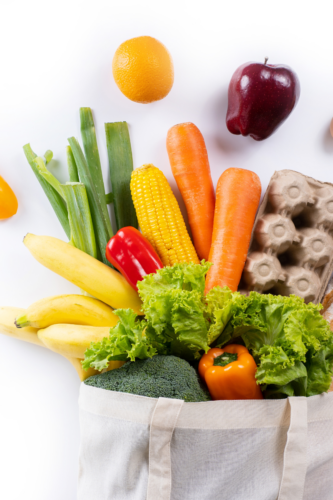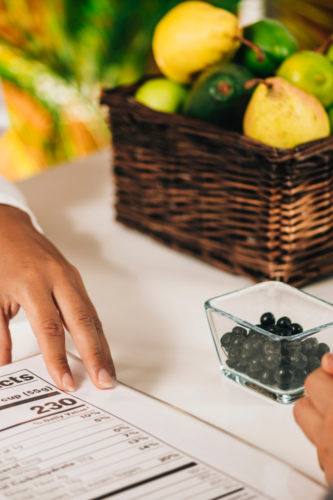Finding Balance While Shopping
While some people seem to be perfectly in tune with what they need when they go to the grocery store, I am not one of those people by nature. Even as a registered dietitian, I sometimes feel lost or overwhelmed in the grocery store if I don’t have a plan and stick to it!

Rules & Tools For Healthy Grocery Shopping
Here are a few rules and tools that I use frequently to help make sure I come home with what I set out to, and have a fridge and pantry stocked with the essentials my family needs to stay nourished and healthy.
Take Stock of What You Have.
Every shopping trip should start with knowing what you already have. Take 10 minutes to look through your pantry, fridge, and freezer to make sure you know what you are starting with. Take note of which ingredients could potentially go together, this is often a great place to start when planning meals for the week. Cleaning out and organizing these areas at least 1-2 times a month can help make this quick check even quicker.Include Your Family In Planning Meals.
It can be challenging planning meals that everyone in your household will enjoy. If you live with others, sit down with them once a week to brainstorm meal ideas. You can also offer choices in the moment – i.e. “We could do tacos, or pasta tonight. What would you like?” Or “would you rather have broccoli, or salad?” This helps everyone not only feel more involved in decision making, but it makes it more likely that they will eat what is prepared. Try to avoid cooking multiple meals (yes even for picky kids!). Not only is this time consuming, but it sets a precedent that is hard to break moving forward. If everyone feels like they have a role in planning and preparing meals, it will be easier to find a common ground that everyone can live with.Make a List of What You Need.
Now that you know what food you have available and have thought about what meals you would like to prepare, you can make a list of what you will need for the week. To avoid going overboard, if you aren’t sure if something should go on the list or in your cart while shopping, simply ask yourself “Is this something we will eat this week?” If you are not someone who likes a written list, even just taking a moment to mentally note the foods you need before shopping can be a helpful practice.


Flexibility is Key
4. Be Flexible.
Since Birch depends on donations and the foods may change every week, it is important to also be flexible if there are certain foods on your list that are not available. Ask yourself – Is there a similar food available? Can I make this dish without that ingredient? Is there another dish I could make with the foods that are available? The more we are able to adapt and get creative, the easier it will be to stick to the plan.
5. Balance Your Food Groups.
While writing your list or even during shopping, take note of the proportion of different food groups in your cart. Health experts and nutrition researchers recommend making the majority of our meals non-starchy vegetables and fruit (about ½ of your plate/bowl), and balancing this out with protein foods (about ¼ of your plate/bowl) and grains/starches (about ¼ of your plate/bowl). With this in mind, we can examine our carts to see how they compare to these guidelines. Is half my cart fruits and vegetables? Am I including protein foods and healthy fats? Do I have some grains and starchy vegetables? Asking these questions can help us see if we are not getting enough – or getting too much – of a particular food group or item.
6. Focus on Whole Foods, But Balance with Convenience Items.
When it comes to healthy eating, it is our overall dietary pattern that is important. Choosing foods that are as close as possible to their natural state (think fresh or frozen fruits and vegetables, fresh or frozen meat, dairy and eggs, nuts and seeds, dry beans or grains, etc.) is one way to help us eat more nutrient-dense foods (foods that are often low in calories and high in nutrients), and eat less calorie-dense foods (foods that are high in calories but often low in nutrients). But luckily, this doesn’t have to be all or nothing! It is okay to have a mix of whole un-processed foods and pre-made or packaged foods. Sometimes “convenience foods” (or foods that have had some form of processing, to reduce cooking or prep time) are very helpful to get through our hectic day-to-day lives. Some examples would be salad kits, pre-cooked chicken patties, canned beans or vegetables, frozen meals, or boxed dinners. You can make these options more nutritionally balanced by adding some frozen vegetables, whole grains, healthy fats or lean protein foods (depending on the food in question).


Remember to Be Realistic
7. Seek Out Variety.
Here at Birch we are lucky to have access to a wide variety of different foods! Some of these foods may be familiar to you, and some of them may not be. While branching out in the kitchen may not be everyone’s strong suit, it pays to be curious. The wider the variety of foods you have in your diet, the more vitamins, minerals, and phytochemicals (powerful antioxidants that are found in foods which contribute to color in fruits, vegetables, legumes, and grains) you will be eating. If you see a fruit or vegetable that you don’t recognize, you can google search by image to learn more about it. Found a grain or seed you’ve never eaten or cooked with before? There are endless recipes and cooking videos online to choose from to find out how to use it. Take the opportunity to try new foods and you might just find a new family favorite.
8. Limit Treat Foods.
The Dietary Guidelines for Americans recommends limiting added sugars (found in soda, juice, and other sweet drinks, candy, baked goods like cakes and cookies, and some sauces/condiments) to less than 10% of calories per day for ages two and up, and to avoid them completely for anyone under age two. It is also recommended to limit saturated fat to less than 10% of calories, and to limit sodium to 2,300 mg per day (both often found in our processed meats and cheeses, chips, fried foods, canned and boxed foods). Notice that this says “limit” and not “banish from your pantry forever”! All foods can fit into a healthy diet, and we should be able to enjoy the foods we love without guilt. Just be intentional about what comes home with you – is it something really special? Is it a special occasion? Or even just – do I really want this? If the answer is yes, then enjoy it in moderation without guilt. But if the answer is no, it may be best to pass on it.
9. Be Realistic & Get Support.
A lot of these tips have focused on planning ahead, eating foods high in nutrients, and getting creative in the kitchen. But these are hard things! It is just as important to acknowledge that none of these things are easy, especially if they are new to you or your household. Be gentle with yourself. Take one step at a time, and know it will not all change overnight. Use these tips as a guide, but know if you need more support it is out there! Ask your doctor to meet with a registered dietitian if you feel you could use more support in making healthy dietary and lifestyle changes. Talk to friends and family about the changes you would like to make, and tell them how they can support you. It’s hard to ask for help sometimes, but it is a lot easier than struggling through alone.
10. Keep What Works, Learn From What Doesn’t.
Remember that this is all a work in progress (yes, even for me!). I am always learning more about how to balance my own health and the health of my family with work and our many other activities and obligations. Take note of what is working well for you, and keep doing more of it! And when something doesn’t work, learn from that too. It is just as important to know what doesn’t work for your household as it is to know what does. So don’t see it as a failure, but an opportunity to grow.


Happy shopping. ☺
Sources:


Shannon Hertzog
As a Birch participant and registered dietitian, Shannon knows first hand how to encourage healthy eating on a budget.
